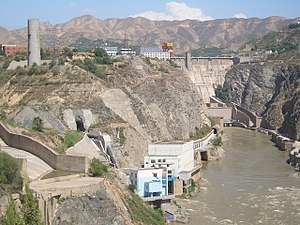
Back Liujiaxia (kapital sa gatos sa Pangmasang Republika sa Tśina, Gansu Sheng, lat 35,93, long 103,32) CEB Liujiaxia-Talsperre German سد لیوجیاکسیا Persian Barrage de Liujiaxia French 劉家峡水力発電所 Japanese Liujiaxiademningen NB Liujiaxia (häradshuvudort i Kina, Gansu Sheng, lat 35,93, long 103,32) Swedish ГЕС Liújiāxiá Ukrainian 刘家峡水电站 Chinese
| Liujiaxia Dam | |
|---|---|
 | |
| Official name | 刘家峡大坝 |
| Coordinates | 35°56′02″N 103°20′34″E / 35.93389°N 103.34278°E |
| Construction began | 1958 |
| Opening date | 1969 |
| Dam and spillways | |
| Type of dam | Gravity dam |
| Impounds | Yellow River |
| Height | 147 m (482 ft) |
| Length | 840 m (2,756 ft) |
| Width (base) | 16 m (52 ft) |
| Reservoir | |
| Creates | Liujiaxia Reservoir |
| Total capacity | 4.24 km3 (1 cu mi) |
| Power Station | |
| Turbines | 3 × 225MW,1 × 250MW,1 × 300MW |
| Installed capacity | 1,225 MW |
The Liujiaxia Dam (Chinese: 刘家峡大坝; pinyin: Liújiāxiá Dàbà) is a major hydroelectric dam on the upper Yellow River, in Linxia Hui Autonomous Prefecture of China's Gansu Province. The dam and its hydroelectric facility (Liujiaxia Hydroelectric Station, Chinese: 刘家峡水电站; pinyin: Liújiāxiá Shuǐdiàn Zhàn) are located in Liujia Gorge, or Liujiaxia (lit. 'Liu Family's Gorge'), just downstream from where the Tao River flows into the Yellow River. The site is on the eastern outskirts of Liujiaxia Town. Since Liujiaxia Town is the county seat of Yongjing County, it is often marked on less detailed maps simply as "Yongjing".
The Liujiaxia Reservoir (Chinese: 刘家峡水库; pinyin: Liújiāxiá Shuǐkù) formed by the dam is the largest body of water within Gansu. The primary purpose of the dam is generating electricity; in addition, it is used for flood control, irrigation, and "ice flood prevention".[1] The dam's location is about 70 km (43 mi) west-south-west (or 100 km (62 mi) upstream[1]) from the provincial capital Lanzhou.
Liujiaxia Dam is a concrete gravity dam 147 m (482 ft) high and 16 m (52 ft) wide on top. The main section of the dam is 204 m (669 ft) long; including auxiliary sections on both sides, the length totals 840 m (2,756 ft).[1][2]
The power plant has 5 generators with the total installed capacity of 1,225 MW.[1][2] When it became fully operational in 1974, it became the country's largest hydroelectric power plant, and remained so until the 1980s.[3]
- ^ a b c d International Association of Engineering Geology (1986). Proceedings, Fifth International Congress, International Association of Engineering Geology, International Association of Engineering Geology. Vol. 2. Taylor & Francis. pp. 1225–1228. ISBN 90-6191-662-3.
- ^ a b Cite error: The named reference
lvyouwas invoked but never defined (see the help page). - ^ Jun Jing (1998). The Temple of Memories: History, Power, and Morality in a Chinese Village. Stanford University Press. pp. 25–27. ISBN 0-8047-2757-0.
© MMXXIII Rich X Search. We shall prevail. All rights reserved. Rich X Search